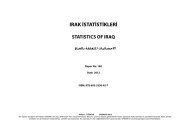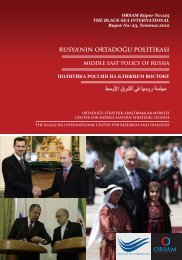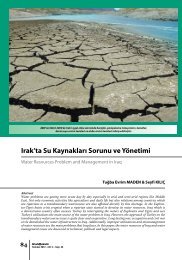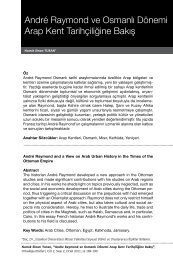30 July - 5 August 2012 - orsam
30 July - 5 August 2012 - orsam
30 July - 5 August 2012 - orsam
Create successful ePaper yourself
Turn your PDF publications into a flip-book with our unique Google optimized e-Paper software.
U.S. Drought and Climate Change: Science Points to Link<br />
The drought that‘s turned most of the United States into a dessicated hotbox may be a symptom of<br />
climate change, a brutal blowback from carbon pollution.<br />
Climate scientists, who prefer to speak in terms of probabilities and trends rather than single events,<br />
are reluctant to point fingers at any one cause — but signs point to human influence making a natural<br />
dry spell unnaturally severe.<br />
―In any single event, it‘s hard to really know if you‘re just seeing a natural variation or climate<br />
change,‖ cautioned climatologist Chris Funk of the University of California, Santa Barbara. With that<br />
caveat, Funk said when asked if human activity exacerbated the drought, ―Tentatively, the answer is<br />
yes. To some extent, it is.‖<br />
Public sentiment has already linked the drought, which has turned much of the Great Plains and<br />
Midwest into disaster areas, wrecking crops and driving food prices dangerously upwards, to<br />
unnatural climate fluctuation. Belief in climate change is now at an all-time U.S. high, and while<br />
explaining the causes of any large weather pattern is always difficult, enough is known about climate<br />
to make some educated guesses.<br />
Funk‘s specialty is the dynamics of sea surface temperatures in the Indian Ocean and western Pacific<br />
Ocean. Over the last century, and in particular the last two decades, these rose by an average of 1.25<br />
degrees Fahrenheit. Ocean temperature trends can be tricky to interpret, but there‘s little scientific<br />
disagreement about Indian Ocean warming: It‘s almost certainly man-made, a result of greenhouse<br />
gases trapping heat in Earth‘s atmosphere.<br />
'When these patterns do materialize, they're materializing in a warming climate.'<br />
The consequences are significant. Heated air holds extra water, supercharging monsoon systems and<br />
producing events like 2010′s Pakistan floods. Water vapor is also a greenhouse gas itself, trapping<br />
heat and creating a feedback loop of local warming.<br />
Page 94
















